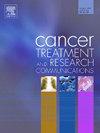Central obesity increases the risk of breast cancer irrespective of menopausal status in women: Systematic review and meta-analysis
IF 2.4
Q3 Medicine
引用次数: 0
Abstract
Background
The incidence of breast cancer increased over the last few decades, however, it is less known about the relationship between central obesity and breast cancer incidence irrespective menopause. Given the increase in the incidence of breast cancer during the past decades, several studies have investigated the effects of variables body mass index on breast cancer, especially obesity. However, this meta-analysis aims to address the relationship between central obesity and risk of pre and postmenopausal breast cancer regardless of the age.
Method
A full electronic search of the Cochrane Library, Scopus, Web of Science, Excerpta Medicine Database (Embase), PubMed, Google Scholar, MESH Medline, and Cancer Literature databases was conducted from 2016 to 2023. The study followed the PRISMA Statement for Systematic Reviews and Meta-analyses protocol. The relevant cohort and case-control studies were screened by two reviewers independently. The data were extracted using Microsoft Excel and analyzed using STATA version 17. Publication bias was detected using a funnel plot, with a p value <0.05 indicate potential publication bias. The I2 test was used to assess the heterogeneity of the studies. The overall estimates with a 95 % confidence interval were estimated using a random effect model analysis.
Results
A total of eight studies with 135,876 women participants were included in this study. The heterogeneity of the studies I2 test was 87.1 %. The overall pooled results, women who presented with central obesity was 2.4 times more likely to develop breast cancer than those who had no history of central obesity (AOR=2.4, 95 % CI; 1.35–4.27).
Conclusion
This study revealed that central obesity is a risk factor of breast cancer. Interventions should be implement to reduce progression of breast cancer through lifestyle change. This study emphasises the need for breast cancer screening and treatment in individuals with central obesity.
中心性肥胖增加乳腺癌的风险与绝经期妇女无关:系统回顾和荟萃分析
在过去的几十年里,乳腺癌的发病率有所增加,然而,人们对中心性肥胖与绝经后乳腺癌发病率之间的关系知之甚少。鉴于过去几十年来乳腺癌发病率的增加,一些研究调查了各种体重指数对乳腺癌,特别是肥胖的影响。然而,本荟萃分析旨在探讨中心性肥胖与绝经前和绝经后乳腺癌风险之间的关系,而不考虑年龄。方法2016 - 2023年对Cochrane Library、Scopus、Web of Science、abstracta Medicine Database (Embase)、PubMed、谷歌Scholar、MESH Medline和Cancer Literature数据库进行全电子检索。本研究遵循PRISMA系统评价声明和meta分析协议。相关的队列研究和病例对照研究由两位评论者独立筛选。使用Microsoft Excel提取数据,使用STATA version 17进行分析。采用漏斗图检测发表偏倚,p值<;0.05表示潜在发表偏倚。I2检验用于评估研究的异质性。使用随机效应模型分析估计总体估计值,置信区间为95%。结果本研究共纳入8项研究,135876名女性受试者。研究ⅱ检验的异质性为87.1%。总体汇总结果显示,出现中心性肥胖的女性患乳腺癌的可能性是没有中心性肥胖史的女性的2.4倍(AOR=2.4, 95% CI;1.35 - -4.27)。结论中心性肥胖是乳腺癌的危险因素之一。应该实施干预措施,通过改变生活方式来减少乳腺癌的进展。这项研究强调了对中心性肥胖患者进行乳腺癌筛查和治疗的必要性。
本文章由计算机程序翻译,如有差异,请以英文原文为准。
求助全文
约1分钟内获得全文
求助全文
来源期刊

Cancer treatment and research communications
Medicine-Oncology
CiteScore
4.30
自引率
0.00%
发文量
148
审稿时长
56 days
期刊介绍:
Cancer Treatment and Research Communications is an international peer-reviewed publication dedicated to providing comprehensive basic, translational, and clinical oncology research. The journal is devoted to articles on detection, diagnosis, prevention, policy, and treatment of cancer and provides a global forum for the nurturing and development of future generations of oncology scientists. Cancer Treatment and Research Communications publishes comprehensive reviews and original studies describing various aspects of basic through clinical research of all tumor types. The journal also accepts clinical studies in oncology, with an emphasis on prospective early phase clinical trials. Specific areas of interest include basic, translational, and clinical research and mechanistic approaches; cancer biology; molecular carcinogenesis; genetics and genomics; stem cell and developmental biology; immunology; molecular and cellular oncology; systems biology; drug sensitivity and resistance; gene and antisense therapy; pathology, markers, and prognostic indicators; chemoprevention strategies; multimodality therapy; cancer policy; and integration of various approaches. Our mission is to be the premier source of relevant information through promoting excellence in research and facilitating the timely translation of that science to health care and clinical practice.
 求助内容:
求助内容: 应助结果提醒方式:
应助结果提醒方式:


